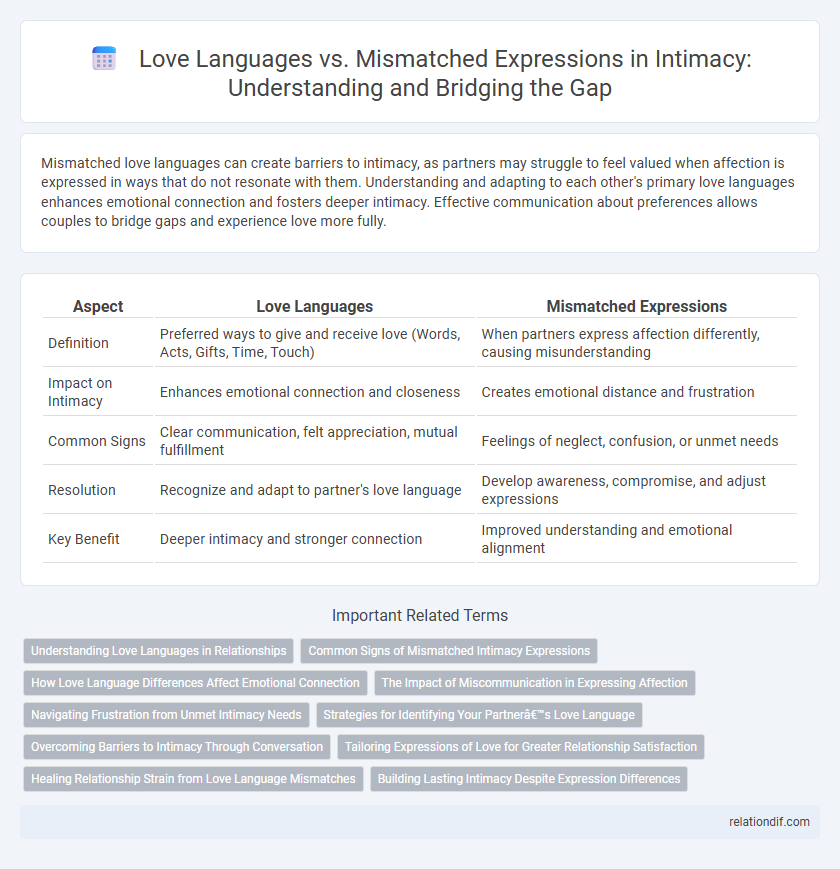Mismatched love languages can create barriers to intimacy, as partners may struggle to feel valued when affection is expressed in ways that do not resonate with them. Understanding and adapting to each other's primary love languages enhances emotional connection and fosters deeper intimacy. Effective communication about preferences allows couples to bridge gaps and experience love more fully.
Table of Comparison
| Aspect | Love Languages | Mismatched Expressions |
|---|---|---|
| Definition | Preferred ways to give and receive love (Words, Acts, Gifts, Time, Touch) | When partners express affection differently, causing misunderstanding |
| Impact on Intimacy | Enhances emotional connection and closeness | Creates emotional distance and frustration |
| Common Signs | Clear communication, felt appreciation, mutual fulfillment | Feelings of neglect, confusion, or unmet needs |
| Resolution | Recognize and adapt to partner's love language | Develop awareness, compromise, and adjust expressions |
| Key Benefit | Deeper intimacy and stronger connection | Improved understanding and emotional alignment |
Understanding Love Languages in Relationships
Understanding love languages is essential for fostering deep emotional connections and preventing misunderstandings in relationships. When partners recognize each other's primary love languages--words of affirmation, acts of service, receiving gifts, quality time, or physical touch--they can express affection in ways that are most meaningful and impactful. Addressing mismatched love language expressions reduces conflict and enhances intimacy by ensuring that each partner feels valued and emotionally fulfilled.
Common Signs of Mismatched Intimacy Expressions
Mismatched love languages often lead to frustration and emotional distance, with common signs including unmet emotional needs, frequent misunderstandings, and feelings of neglect or rejection. Partners may struggle with recognizing or valuing each other's preferred expressions, such as physical touch, words of affirmation, or acts of service. Identifying these signs early can foster better communication and strengthen intimacy by aligning emotional expressions.
How Love Language Differences Affect Emotional Connection
Love language differences can create barriers to emotional connection when partners express affection in mismatched ways, leading to feelings of neglect or misunderstanding. For example, one partner valuing acts of service while the other prioritizes words of affirmation may struggle to recognize each other's love. Understanding and adapting to each other's preferred love languages fosters deeper emotional intimacy and strengthens relational bonds.
The Impact of Miscommunication in Expressing Affection
Miscommunication in expressing affection can lead to significant emotional distance when love languages are mismatched, as individuals may feel unloved or misunderstood despite genuine intentions. For example, a partner who values acts of service may not recognize verbal affirmations as meaningful, causing frustration and feelings of neglect. Understanding and adapting to each other's primary love language reduces misunderstandings and strengthens emotional connections in intimate relationships.
Navigating Frustration from Unmet Intimacy Needs
Navigating frustration from unmet intimacy needs requires recognizing the differences in love languages, such as words of affirmation, acts of service, physical touch, quality time, and receiving gifts. Misaligned expressions often cause feelings of neglect or misunderstanding, intensifying emotional distance between partners. Effective communication and empathy can bridge these gaps, fostering deeper emotional connection and mutual fulfillment.
Strategies for Identifying Your Partner’s Love Language
Identifying your partner's love language involves closely observing how they express affection and respond to different gestures, such as acts of service, words of affirmation, physical touch, quality time, or receiving gifts. Engaging in open, empathetic conversations about emotional needs helps clarify their preferred love language while reducing misunderstandings caused by mismatched expressions. Practicing consistent, intentional efforts to speak their love language strengthens emotional intimacy and fosters a deeper connection.
Overcoming Barriers to Intimacy Through Conversation
Effective communication bridges love languages and mismatched expressions by fostering understanding and emotional connection in intimate relationships. Conversations that explore partner preferences and clarify intentions help dismantle barriers caused by differing ways of expressing love. Deep, empathetic dialogue cultivates mutual respect and strengthens emotional bonds, enhancing intimacy despite initial communication gaps.
Tailoring Expressions of Love for Greater Relationship Satisfaction
Tailoring expressions of love to align with individual love languages enhances emotional connection and reduces misunderstandings in relationships. Recognizing and adapting to differences in love languages, such as words of affirmation, acts of service, or physical touch, fosters deeper intimacy and satisfaction. Couples who actively communicate and honor each other's preferred ways of giving and receiving love experience stronger bonds and lasting fulfillment.
Healing Relationship Strain from Love Language Mismatches
Understanding and respecting different love languages plays a crucial role in healing relationship strain caused by mismatched expressions of affection. Partners can rebuild connection by actively learning each other's primary love languages, such as words of affirmation, acts of service, or physical touch, to foster emotional intimacy and reduce misunderstandings. Targeted communication strategies and mutual empathy enhance the ability to meet emotional needs, strengthening bonds despite initial love language differences.
Building Lasting Intimacy Despite Expression Differences
Understanding love languages enhances emotional connection by recognizing how partners uniquely express affection, such as through words, acts, or touch. Addressing mismatched expressions involves active communication, empathy, and intentional effort to meet each other's emotional needs authentically. Building lasting intimacy requires adapting love language awareness into daily interactions, fostering trust, and deepening vulnerability despite initial differences.
Love languages vs mismatched expressions Infographic

 relationdif.com
relationdif.com